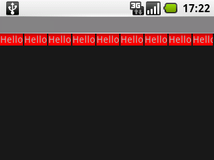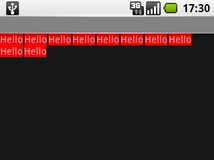我制作了自己的布局,可以做我想要的,但目前它非常有限。当然,欢迎提出意见和改进建议。
活动:
package se.fnord.xmms2.predicate;
import se.fnord.android.layout.PredicateLayout;
import android.app.Activity;
import android.graphics.Color;
import android.os.Bundle;
import android.widget.TextView;
public class Predicate extends Activity {
/** Called when the activity is first created. */
@Override
public void onCreate(Bundle savedInstanceState) {
super.onCreate(savedInstanceState);
PredicateLayout l = new PredicateLayout(this);
for (int i = 0; i < 10; i++) {
TextView t = new TextView(this);
t.setText("Hello");
t.setBackgroundColor(Color.RED);
t.setSingleLine(true);
l.addView(t, new PredicateLayout.LayoutParams(2, 0));
}
setContentView(l);
}
}
或者在 XML 布局中:
<se.fnord.android.layout.PredicateLayout
android:id="@+id/predicate_layout"
android:layout_width="fill_parent"
android:layout_height="wrap_content"
/>
布局:
package se.fnord.android.layout;
import android.content.Context;
import android.util.AttributeSet;
import android.view.View;
import android.view.ViewGroup;
/**
* ViewGroup that arranges child views in a similar way to text, with them laid
* out one line at a time and "wrapping" to the next line as needed.
*
* Code licensed under CC-by-SA
*
* @author Henrik Gustafsson
* @see http://stackoverflow.com/questions/549451/line-breaking-widget-layout-for-android
* @license http://creativecommons.org/licenses/by-sa/2.5/
*
*/
public class PredicateLayout extends ViewGroup {
private int line_height;
public PredicateLayout(Context context) {
super(context);
}
public PredicateLayout(Context context, AttributeSet attrs){
super(context, attrs);
}
@Override
protected void onMeasure(int widthMeasureSpec, int heightMeasureSpec) {
assert(MeasureSpec.getMode(widthMeasureSpec) != MeasureSpec.UNSPECIFIED);
final int width = MeasureSpec.getSize(widthMeasureSpec);
// The next line is WRONG!!! Doesn't take into account requested MeasureSpec mode!
int height = MeasureSpec.getSize(heightMeasureSpec) - getPaddingTop() - getPaddingBottom();
final int count = getChildCount();
int line_height = 0;
int xpos = getPaddingLeft();
int ypos = getPaddingTop();
for (int i = 0; i < count; i++) {
final View child = getChildAt(i);
if (child.getVisibility() != GONE) {
final LayoutParams lp = (LayoutParams) child.getLayoutParams();
child.measure(
MeasureSpec.makeMeasureSpec(width, MeasureSpec.AT_MOST),
MeasureSpec.makeMeasureSpec(height, MeasureSpec.UNSPECIFIED));
final int childw = child.getMeasuredWidth();
line_height = Math.max(line_height, child.getMeasuredHeight() + lp.height);
if (xpos + childw > width) {
xpos = getPaddingLeft();
ypos += line_height;
}
xpos += childw + lp.width;
}
}
this.line_height = line_height;
if (MeasureSpec.getMode(heightMeasureSpec) == MeasureSpec.UNSPECIFIED){
height = ypos + line_height;
} else if (MeasureSpec.getMode(heightMeasureSpec) == MeasureSpec.AT_MOST){
if (ypos + line_height < height){
height = ypos + line_height;
}
}
setMeasuredDimension(width, height);
}
@Override
protected LayoutParams generateDefaultLayoutParams() {
return new LayoutParams(1, 1); // default of 1px spacing
}
@Override
protected boolean checkLayoutParams(LayoutParams p) {
return (p instanceof LayoutParams);
}
@Override
protected void onLayout(boolean changed, int l, int t, int r, int b) {
final int count = getChildCount();
final int width = r - l;
int xpos = getPaddingLeft();
int ypos = getPaddingTop();
for (int i = 0; i < count; i++) {
final View child = getChildAt(i);
if (child.getVisibility() != GONE) {
final int childw = child.getMeasuredWidth();
final int childh = child.getMeasuredHeight();
final LayoutParams lp = (LayoutParams) child.getLayoutParams();
if (xpos + childw > width) {
xpos = getPaddingLeft();
ypos += line_height;
}
child.layout(xpos, ypos, xpos + childw, ypos + childh);
xpos += childw + lp.width;
}
}
}
}
结果如下:










